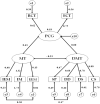Critical Thinking and Motivation in Vocational Training and Baccalaureate: A Comparison Study of Students of Spanish Nationality, Unaccompanied Foreign Minors and Young Care Leavers
- PMID: 35564666
- PMCID: PMC9103581
- DOI: 10.3390/ijerph19095272
Critical Thinking and Motivation in Vocational Training and Baccalaureate: A Comparison Study of Students of Spanish Nationality, Unaccompanied Foreign Minors and Young Care Leavers
Abstract
The present study analyzed academic motivation and its relationship with dispositions towards critical thinking in a sample of 131 students of Spanish nationality and 131 students of foreign nationality (unaccompanied foreign minors and foreign adolescents who had previously experienced the Andalusian care system). For this, an ex-post-facto study was conducted which was descriptive, comparative, and cross-sectional in nature. The main analyses carried out are of a descriptive and inferential nature, the latter to analyze the differences and associations between the variables of critical thinking and motivation (ANOVA test and an structural equations models) in both groups. Main outcomes included the lack of significant differences in dispositions towards critical thinking between Spanish and foreign students, alongside the existence of significant differences in academic motivation between both of these groups. In addition to this, significant differences were found within the group of Spanish nationality students in the dimensions of critical thinking as a function of intrinsic motivation, whilst such differences emerged in the foreign nationality group as a function of intrinsic and extrinsic motivation and amotivation. Finally, within the group of Spanish students, a significant and positive relationship was found between motivation and critical thinking, being positive and non-significant in the foreign national group. In conclusion, it is necessary to improve dispositions towards critical thinking and educational motivation from the educational system for the inclusion of minors and youths in today's society.
Keywords: baccalaureate; motivation and critical thinking; unaccompanied foreign minors; vocational training; young care leavers.
Conflict of interest statement
The authors declare no conflict of interest.
Figures


Similar articles
-
The relationship of critical thinking skills and critical thinking dispositions of baccalaureate nursing students.J Adv Nurs. 2003 Sep;43(6):569-77. doi: 10.1046/j.1365-2648.2003.02755.x. J Adv Nurs. 2003. PMID: 12950562
-
Critical thinking skills and dispositions of baccalaureate nursing students--a conceptual model for evaluation.J Prof Nurs. 1997 Jul-Aug;13(4):236-45. doi: 10.1016/s8755-7223(97)80094-4. J Prof Nurs. 1997. PMID: 9239982
-
Motivation for Critical Thinking in Nursing Students in Chile.Hisp Health Care Int. 2021 Jun;19(2):131-137. doi: 10.1177/1540415320970110. Epub 2020 Nov 26. Hisp Health Care Int. 2021. PMID: 33243019
-
Teaching critical thinking skills to undergraduate nursing students.Nurse Educ. 1997 May-Jun;22(3):37-9. doi: 10.1097/00006223-199705000-00016. Nurse Educ. 1997. PMID: 9197656 Review.
-
Critical thinking dispositions of nursing students in Asian and non-Asian countries: a literature review.Glob J Health Sci. 2013 Sep 26;5(6):172-8. doi: 10.5539/gjhs.v5n6p172. Glob J Health Sci. 2013. PMID: 24171885 Free PMC article. Review.
Cited by
-
Strategies to improve academic motivation in undergraduate nursing students in Iran: a qualitative content analysis.BMC Res Notes. 2025 Jul 30;18(1):334. doi: 10.1186/s13104-025-07322-z. BMC Res Notes. 2025. PMID: 40739249 Free PMC article.
References
-
- Sølvik R.M., Glenna A.E.H. Teachers’ potential to promote students’ deeper learning in whole-class teaching: An observation study in Norwegian classrooms. J. Educ. Chang. 2021 doi: 10.1007/s10833-021-09420-8. - DOI
-
- Vallejo M., Torres-Soto A. Calidad de los aprendizajes de estudiantes de pedagogía: Influencia del modelo educativo. Rev. Fuentes. 2020;22:238–250. doi: 10.12795/revistafuentes.2020.v22.i2.01. - DOI
-
- Núñez J.C., Solano P., González-Pienda J.A., Rosário P. El aprendizaje autorregulado como medio y meta de la educación. [(accessed on 15 October 2021)];Pap. Psicólogo. 2006 27:139–146. Available online: https://www.redalyc.org/articulo.oa?id=77827303.
-
- Hernández F., Monroy F., Maquilón J. La acción tutorial y el fomento del proceso de aprendizaje. In: Expósito-López J., editor. La Acción Tutorial en la Educación Actual. 1st ed. Editorial Síntesis; Madrid, España: 2014. pp. 211–226.
-
- De la Fuente J., Pichardo M.C., Justicia F., Berbén A. Enfoques de aprendizaje, autorregulación y rendimiento en tres universidades europeas. [(accessed on 2 November 2021)];Psicothema. 2008 20:705–711. Available online: https://www.redalyc.org/articulo.oa?id=72720430. - PubMed
Publication types
MeSH terms
LinkOut - more resources
Full Text Sources

